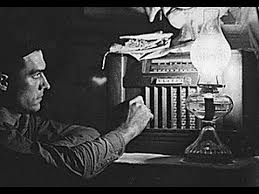The lights go down, the curtain goes up, and the sound of rain and thunder fills the theatre. Onstage, a full moon is brilliantly illuminated in red, while in the shadows a dark, winged figure triumphantly holds up a baby amidst the cracking of the thunder.
And then the scene quickly changes, the music of Tchaikovsky starts, and a simple yet iconic phrase is projected onto the stage curtains: Once Upon A Time . . .
Trailer for Bourne’s New Adventure production of "Sleeping Beauty"
This is the story of Sleeping Beauty reimagined by Matthew Bourne, keeping the timeless music of Tchaikovsky but incorporating, through the narrative and choreography, what Bourne’s New Adventure production has titled ‘A Gothic Romance.’ I am by no means an expert in ballet or classical music, but what interested me in this production was its claim to the title ‘Gothic Romance,’ and therefore its conscious effort to situate itself within the Gothic tradition. My obsession with all things Gothic is in fact what prompted my mum to buy tickets to this production, and it is definitely a show worth seeing.
So, does Bourne’s "Sleeping Beauty" live up to its Gothic claim? As you may already be aware, Bourne is celebrated for his modern re-imaginings of classic ballets. In keeping with this principle, and completing his productions of Tchaikovsky’s trilogy of Ballets (which also include The Nutcracker and Swan Lake), Bourne’s version of the well-known fairy tale Sleeping Beauty is suitably re-imagined with Gothic, and even vampiric, elements. Discussing his inspiration for this production in the show’s program, Bourne cites the versions of the fairy tale by Perrault, the Brothers Grim, and also Disney, but further mentions ‘erotic novels by Anne Rice’ and ‘dark stories by Angela Carter.’ It is clear that these varied sources are reflected in the production; from the traditional ‘Once upon a time’ beginning, to the inclusion of vampires.
 |
| Carabosse and her two attendants. Photo by Johan Persson © |
Yet even without the inclusion of this vampiric element, Bourne’s production of "Sleeping Beauty" is enchantingly Gothic. At Sheffield Gothic, we frequently discuss the Gothic nature of fairy tales (yes – even Disney versions, cue chants of ‘everything is Gothic’), and Angela Carter’s Bloody Chamber is perhaps the best example of this. Carter’s stories do not reimagine traditional fairy stories such as Blue Beard (‘The Bloody Chamber’), Snow White (‘The Snow Child’), and even Sleeping Beauty (The Lady of the House of Love’), but rather her collection brings to the surface that which is latent within them; revealing themes, content, and an aesthetic that is very much Gothic. This is very much the case for Bourne’s "Sleeping Beauty", with its introduction of the dark origins of the heroine Aurora, the curse of the malevolent Carabosse, and the vampiric land of the fairies.
 |
| Program for Matthew Bourne's "Sleeping Beauty" |

The character of Carabosse further stands out as an apt Gothic villain, and the theme of doubles is raised through the characters of this dark fairy and her son, Caradoc. Further enhancing both the familial resemblance and also the theme of doubles in the production, these characters are fittingly played by the same dancer. Introduced fleetingly in the shadowy opening sequence, it is in the bedroom of the baby Aurora (who is portrayed by a rather creepy doll) that Carabosse is properly, and very dramatically, introduced to the audience; dressed opulently in red, she arrives on a train of smoke, led by her two attendants, and silhouetted against the full moon. In this scene, Carabosse displays her malevolent intentions for Aurora, and at one point uses a faceless apparition to uncannily act out the heroine’s fated death. Following the intervention of the vampiric fairies, led by Count Lilac, and as the fairy tale narrative naturally requires, the intended death of Aurora is transformed into a long and supernatural sleep. Thus it falls to her son Caradoc, a character created by Bourne to continue these malevolent themes throughout his production, to carry out his mother’s vengeful plans; the plot of revenge therefore takes on a suitably Gothic, familial characteristic.
Bourne’s production is an enchantingly beautiful and Gothic version of the Sleeping Beauty fairy story. Reimagining Tchaikovsky’s classical ballet with a Gothic and vampiric twist, he reveals the Gothic aspects inherent in the fairy story. In keeping with the ‘Once upon a time’ aesthetic and conventional happy ending, but also including a few vampires along the way, this production of "Sleeping Beauty" is definitely a show worth seeing for any fan of the Gothic.
Mary Going is a postgraduate researcher at the University of Sheffield. She is our very own vampire fairy, spreading Gothic joy wherever she goes...















